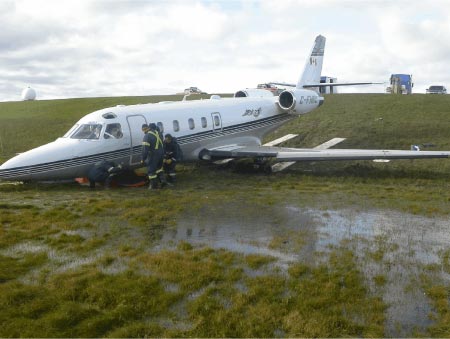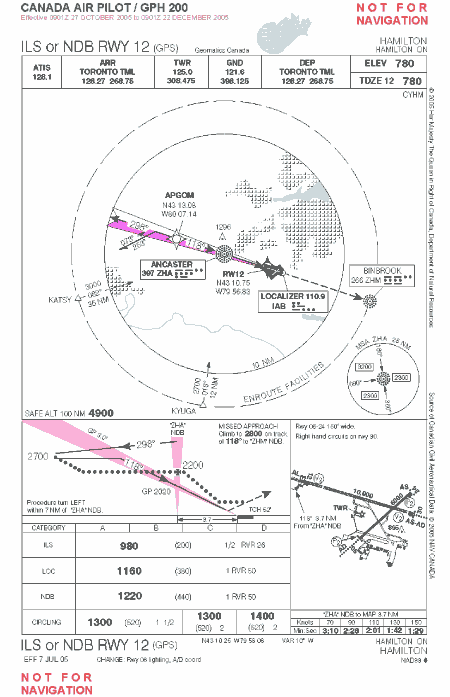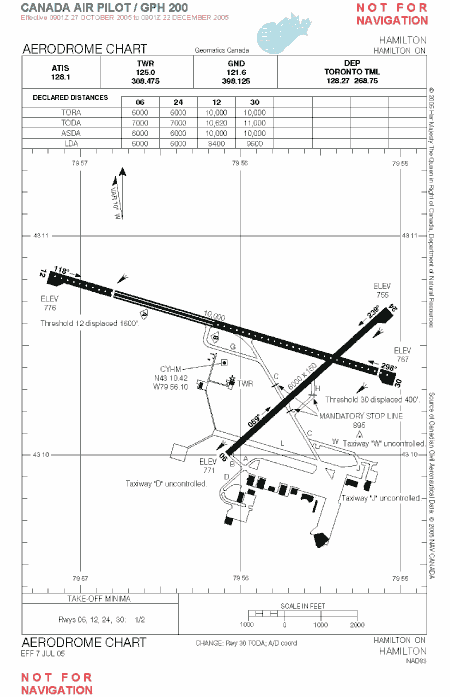Runway Overrun
Jetport Inc.
Gulfstream 100 C-FHRL
Hamilton Airport, Ontario
The Transportation Safety Board of Canada (TSB) investigated this occurrence for the purpose of advancing transportation safety. It is not the function of the Board to assign fault or determine civil or criminal liability. This report is not created for use in the context of legal, disciplinary or other proceedings. See Ownership and use of content. Masculine pronouns and position titles may be used to signify all genders to comply with the Canadian Transportation Accident Investigation and Safety Board Act (S.C. 1989, c. 3).
Summary
The Gulfstream 100 (registration C-FHRL, serial number 150), operated by Jetport Inc., was conducting an instrument flight rules flight from West Palm Beach, Florida, to Hamilton, Ontario, with two pilots on board. The co-pilot was seated in the left seat and was the pilot flying. Approaching the destination, the flight was cleared for the instrument landing system approach to Runway 12 at the Hamilton Airport. The approach was at night in instrument meteorological conditions.
At 400 to 500 feet above ground level, the flight crew saw the runway. At approximately 1902 eastern standard time, the aircraft touched down on the wet runway with about 3000 feet of runway remaining. The flight crew used all available braking systems to slow the aircraft. However, it ran off the end of the runway and travelled 122 feet downslope before it came to an abrupt stop when the nosewheel sheared off. The aircraft sustained substantial damage, but neither flight crew member was injured during the runway excursion. The emergency locator transmitter activated, and the aircraft rescue and firefighting teams responded.
Factual information
History of the Flight
The pilots began their duty day at 0830 eastern standard time (EST)Footnote 1 flight planning at the Jetport Inc. base of operation at Hamilton Airport, Ontario. This was a charter flight, the purpose of which was to fly to Toronto/Lester B. Pearson International Airport, Ontario, pick up two passengers and fly them to West Palm Beach, Florida, and return to Hamilton. This was the first time that the pilots were scheduled to fly together. The co-pilot was new to the company, and was designated to be the pilot flying (PF) during the leg from West Palm Beach to Hamilton.
The first two legs of the flight were completed. Nearing Hamilton on the last leg, the crew received the latest weather reports and automatic terminal information service (ATIS) for Hamilton Airport. The Toronto Area Control Centre (ACC) provided the flight crew with radar vectors and issued a clearance for the instrument landing system (ILS) Runway 12 approach.
The aircraft encountered heavy precipitation and turbulence while being vectored for the approach. The flight crew decided to add 10 knots to the calculated landing reference speed (Vref) of 125 knots and conducted the approach at 135 knots indicated airspeed. Before reaching the approach decision height, the flight crew acquired the runway environment visually and proceeded with the landing. The PF disengaged the autopilot, continued the approach, and flared the aircraft for landing. He did not reduce the power to idle until prompted by the pilot not flying (PNF). Because of the excess airspeed and power, the aircraft floated and touched down further along the runway than planned.
The flight crew were unable to indicate the aircraft touchdown point on the runway. The aircraft was observed to touch down between Charlie taxiway and the intersection of runways 12/30 and 06/24, with approximately 3000 feet of runway remaining. A review of the recorded radar data indicated that the aircraft's speed did not decrease below 130 knots until the aircraft was entering the intersection of the runways. After touchdown, the PNF prompted the PF to deploy the thrust reversers. All braking systems (aircraft brakes, spoilers, thrust reversers) were used to slow the aircraft. However, it rolled 122 feet past the end of the runway and down sloping grass terrain. The aircraft incurred substantial damage when the nose landing gear sheared off, the right main landing gear struck two steel survey stakes, and the right wing struck an aerodrome lighting standard and terrain.
Personnel Information
The flight crew were certified and qualified for the flight in accordance with existing regulations. The pilot-in-command had 3600 flying hours, including 600 hours on the aircraft type and was seated in the right seat as the PNF during the occurrence flight.
The co-pilot had 5600 flying hours, including 14 hours on type and received his aircraft type training at Flight Safety International in Dallas, Texas. He flew the previous two days as the PNF for a total of 8.4 flying hours, and flew as the PNF on the first two legs of this flight. On the occurrence flight, he was seated in the aircraft's left seat and was acting as the PF for the first time on this aircraft type.
Airport / Runway Information
Hamilton Airport has two asphalt-surfaced runways (see Appendix B). The runway in use, Runway 12, is 10 000 feet long and 200 feet wide and has a displaced threshold of 1600 feet, leaving a landing distance available of 8400 feet. The ILS or NDB RWY 12 approach is shown in Appendix A. The decision height and advisory visibility for this approach are 980 feet above sea level (asl) (200 feet above ground level (agl)) and ½ statute mile (sm), respectively. The terrain past the end of Runway 12 is level for approximately 25 feet. It then slopes down for approximately 100 feet before it levels to a marshy area.
The latest airfield condition report, completed at 1429 on the day of the occurrence, indicated that all runways were 100 per cent bare and wet with standing water present. Runway friction tests were conducted on 30 May 2005, and a copy of the runway report was obtained. It indicated that Runway 12/30 showed significant and clearly defined dips in the friction values at both ends. Friction values in the touchdown areas at both ends of the runway were comparable to, or just below, the Transport Canada runway maintenance planning level. These lower friction levels were most likely due to cumulative texture loss and rubber contamination resulting from aircraft landing operations.
Tire marks were found on the paved surface of the runway just before the aircraft's departure onto the grass. The tire marks were very faint and light to dark grey, darkest in colour on the right side of both of the main landing gear. Once the runway surface dried, the tire marks were visible for several hundred metres when viewed from a distance and at a shallow angle. The tire marks indicate that the aircraft crossed the centreline of the runway from left to right and was tracking fairly straight. Just before the aircraft left the paved surface, the nose landing gear track crossed over the left main landing gear track, indicating that the aircraft yawed to the left as it exited the runway. The darkness of the tire marks on the right sides of the main landing gear was most likely the result of the aircraft being in a left, sideways skid as it exited the runway.
Meteorological Information
The aviation routine weather report (METAR) at 1900 for Hamilton Airport was as follows: winds 060° True at 15 gusting to 22 knots; visibility 1 sm in light rain and mist; ceiling 300 feet agl broken, 800 feet agl broken, 1700 feet agl overcast; temperature 7°C, dew point 7°C, altimeter setting 29.78 inches of mercury (in. Hg); and remarks fog 3/8, stratus fractus 2/8, stratus fractus 1/8, and stratocumulus 2/8.
The ATIS for Hamilton Airport was broadcast as follows:
Hamilton Airport information Foxtrot, weather at 2300 Zulu [1800 EST] wind 050° at 13 knots, visibility 1 mile, light rain, mist, ceiling 300 feet broken, 500 feet overcast, temperature 8°C, dew point 8°C, altimeter 29.83, IFR approach ILS Runway 12, landing Runway 12, departing Runway 12, runway surface condition at 1929 Zulu [1429 EST], runways 100% bare and wet, standing water present, most at the intersection of Runways 12 and 06. Inform ATC that you have information Foxtrot.
Aircraft Information
Records indicate that the aircraft was certified, equipped, and maintained in accordance with existing regulations and approved procedures. There was no indication of any airframe failure or system malfunction during the flight. When the aircraft rolled off the end of the runway, the landing gear was down and locked, the flaps/slats were fully extended, the speed brakes/spoilers were deployed, and the thrust reversers were deployed. The weight and centre of gravity were within the prescribed limits.
The aircraft was equipped with a cockpit voice recorder (CVR), model Universal CVR 30-B, serial number DU1141. This model is a semi-conductor recorder, with four continuous-loop channels, that records all voice messages sent or received by the crew in the last 30 minutes. The CVR was forwarded to the TSB Engineering Laboratory for analysis. The information and conversations retrieved provided a record of the events that occurred during the 30 minutes prior to the aircraft being shut down. The aircraft was not equipped with a flight data recorder (FDR), nor was it required by regulation.
An inspection of the aircraft's main gear tires showed that there was limited tire tread depth remaining, although the depth on all of the tires was within specified limits. The pressures were checked on all of the tires and were found to be within the specified limits. Tire tread depth and tire pressure both play an important role in preventing hydroplaning.
The aircraft's landing weight was 18 250 pounds, and from the aircraft performance charts, the unfactored landing distance on a wet runway was determined to be about 3200 feet. This unfactored distance is the distance travelled from 50 feet above the runway to fully stopped, and reflects normal ambient conditions, a perfect approach, and landing with anti-skid on, lift dump (spoilers) on/out, and thrust reversers not used. Approximately 1000 feet of the 3200 feet would be used descending from 50 feet to touchdown, leaving about 2200 feet to bring the aircraft to a stop on the wet runway.
Since the aircraft touched down with about 3000 feet of runway remaining, it should have been able to stop in the remaining distance available, especially since thrust reversers were used. Factors that contributed to the aircraft going off the end of the runway may have been a touchdown speed higher than Vref, slow deployment of the thrust reversers, standing water at the intersection of the runways, friction values at the runway ends that were at or below the Transport Canada runway maintenance planning level, and limited tire tread depth. These factors likely contributed to the aircraft hydroplaning as described below.
Hydroplaning
When hydroplaning occurs, the tires of the aircraft completely lose contact with the actual runway surface. They will continue to hydroplane until a reduction in speed permits the tires to regain contact with the runway surface. During dynamic hydroplaning, the tire lifts off the runway and rides on a wedge of water, causing such a complete loss of tire friction that wheel spin-up will not occur.
On wet runways, where there is not enough water to cause dynamic hydroplaning, viscous hydroplaning can occur. This term describes the normal slipperiness or lubricating action of water. Viscous hydroplaning does not reduce the friction to such a low level that wheel spin-up will not occur. On the other hand, reverted rubber hydroplaning can occur when a locked tire is skidded along a very slippery water- or slush-contaminated runway at any speed above about 20 knots, at which point the friction-generated heat produces steam and begins to revert the rubber, on a portion of the tire, to its uncured state.
Generally speaking, the speed at which a tire will hydroplane can be calculated by multiplying the square root of the tire pressure by nine. In this occurrence, with a nominal tire pressure of 135 psi, this would equate to hydroplanning speeds of 105 knots for the main landing gear and 85 knots for the nose landing gear. Above 105 knots, it is possible for both the main landing gear tires to hydroplane. This would affect the ability of the aircraft's brake system to deliver effective braking, even with an anti-skid system. Indications of hydroplaning were noted when investigators observed reverted rubber on both the left main gear tires, although none could be found on the other tires.
The following TSB Engineering Laboratory report was completed:
- LP 122/2005 – CVR Download.
This report is available from the Transportation Safety Board of Canada upon request.
Findings as to Causes and Contributing Factors
- The pilot flying was slow to reduce the power to idle after flaring the aircraft for landing. Due to the excess airspeed and power, the aircraft floated, touching down with approximately 3000 feet of runway remaining.
- Although the available 3000 feet of runway remaining exceeded the unfactored estimated ground roll of 2200 feet, the aircraft was unable to stop. A touchdown speed higher than the landing reference speed (Vref), slow deployment of the thrust reversers, standing water at the intersection of the runways, friction values at the runway ends that were at or below the Transport Canada runway maintenance planning level, and limited tire tread depth likely contributed to the runway excursion.
- During the landing roll, the aircraft's tires hydroplaned, reducing the braking forces.
This report concludes the Transportation Safety Board's investigation into this occurrence. Consequently, the Board authorized the release of this report on .


